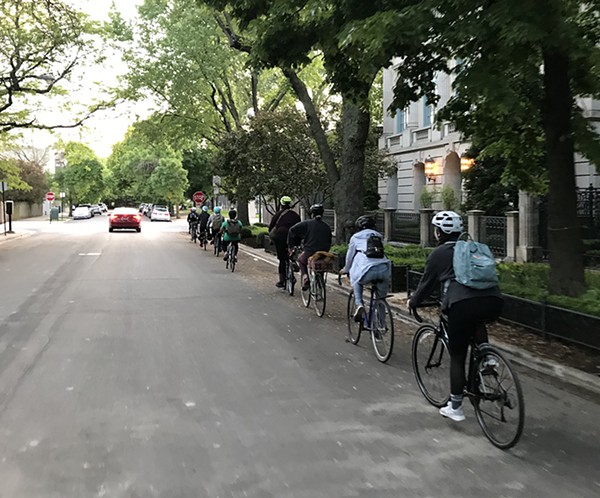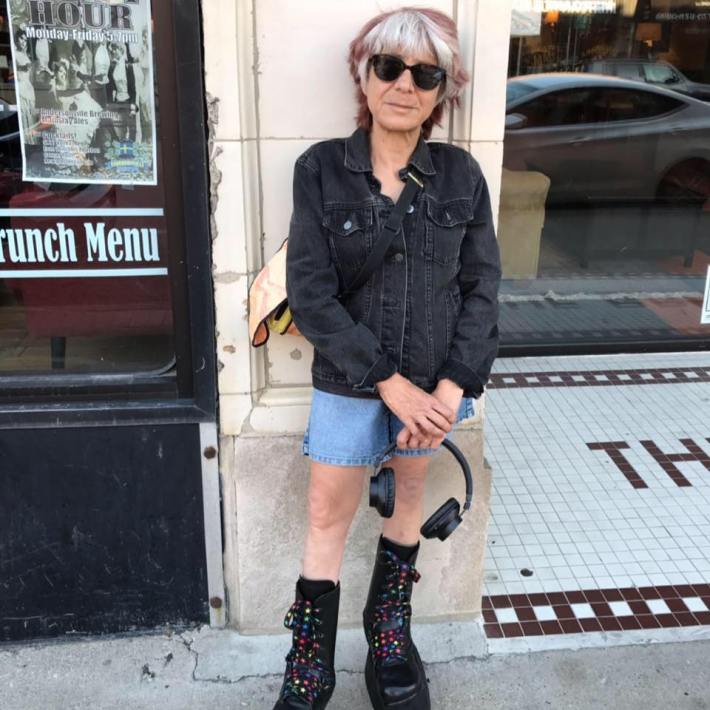Cyclephobia: Fears of Reckless Bike Riders May Be Overblown, but Empathy Is Still Needed
3:53 PM CDT on August 8, 2019

Cyclists on Dickens Avenue in Lincoln Park. Photo: John Greenfield
[This article previously ran in the Chicago Reader.]
People are capable of acting like irresponsible idiots whether they're traveling on foot, by bicycle, or in a car. And obviously the potential for causing death and destruction is exponentially greater when you're piloting a high-speed, multiton vehicle.
But even a cycling advocate like me has to acknowledge that Riva Lehrer, 61, an artist and writer who teaches at SAIC and Northwestern, has had some truly awful luck when it comes to run-ins with selfish jerks on bikes.
"I have spina bifida and I wear giant orthopedic boots, and I walk with a very strong limp," Lehrer says. "But I try to go for long walks every day." However, Lehrer's disability makes it difficult to get out of the way when she encounters adults illegally riding at unsafe speeds on sidewalks in the Loop and along busy north-side streets like Clark, Broadway, and Sheridan.
Lehrer says that over the last 30 years she's had hundreds of near misses, and that sidewalk cyclists have struck her at least 25 times, resulting in knocked-out teeth, a split-open chin, broken fingers, and even a spinal cord injury. Appallingly, she reports, "not one of them stopped to see if I was OK."
Drivers have also hit Lehrer. For example, she says, once when she was walking her dog in Rogers Park, a motorist ran a stop sign, knocking her over, and fled the scene. "But with drivers it's different, because you know you're in a danger zone." She adds that because bikes are relatively silent, she's often startled by sidewalk riders approaching her from behind.
Lehrer says that when she asks people not to pedal on the sidewalk, they'll sometimes reply that it's too dangerous to ride in the street, but often will just curse at her. She adds that her experiences with negligent bike riders have left her traumatized and bitter.
Her story is a reminder that, while bike-pedestrian crashes are less common and typically much less severe than the daily carnage inflicted by reckless drivers, they're no laughing matter. That's especially true for people with disabilities and seniors, for whom a fall is more likely to have serious consequences like a broken hip.

I learned about Lehrer after I posted on Facebook that, in my experience, many folks who don't bike regularly seem to have a primal fear of being struck by cyclists that's disproportionate to the potential danger, relative to the prevalence and severity of motor vehicle-pedestrian crashes.
This was on my mind after I witnessed the backlash to the city's proposal to build a traffic-calmed "neighborhood greenway" bike route on Dickens Avenue in Lincoln Park. During a hearing on the project, several residents argued that more cycling on the side street would endanger families. They didn't seem to appreciate that the initiative would also include lowering the speed limit and installing sidewalk bump-outs and raised crosswalks, which would discourage speeding by drivers and make it easier to cross the street.
One neighbor actually argued that people move to Dickens to get away from bike traffic, drawing a round of applause. "How many bicyclists have killed or hurt pedestrians compared to drivers?" shot back another attendee.
While I've found no record of a bike rider ever fatally striking a pedestrian in Chicago in the modern era, drivers struck and killed 41 people on foot in Chicago in 2018, as well as five people biking, according to preliminary police data.
It's more difficult to compare the number of Chicago pedestrians hurt in bike crashes to the number injured in car crashes, because the police department doesn't track bike-pedestrian collisions. According to the Active Transportation Alliance's Chicago Regional Crash Report published last year, 2,710 people were injured while walking in the city in 2016. Since, according to Census data, only 1.7 percent of Chicagoans bike to work, it's a fair assumption that motorists struck the vast majority of those injured pedestrians.
New York City does track bike-pedestrian crashes, and the New York Times recently reported that in 2017 one pedestrian was killed in a bike collision, while 315 people on foot were injured. That same year, however, motorists fatally struck 107 people walking, and injured more than 15,000. Pedestrians were about 48 times as likely to be injured in a motor vehicle crash as in a bike collision.
"The small risk from bicycles pales in comparison to the deadly risk from cars and trucks," Marco Conner from the NYC advocacy group Transportation Alternatives told the Times. "There is a false picture that has been painted of cyclists pitted against pedestrians, whereas both cyclists and pedestrians are vulnerable road users."
Conner's counterpart Heather Schady from Active Trans says she's not convinced that Chicagoans are disproportionately afraid of being hit by cyclists compared to being struck by motorists: "In our experience people walking are most concerned about getting hit by drivers."
Schady notes that well-designed on-street bike lanes can improve safety for people walking by helping cyclists feel comfortable staying off the sidewalk. She added that creating separate paths for pedestrians and bike riders on off-street trails, as was recently done on the Lakefront Trail, can help prevent conflicts.
I asked Joe Ferrari, a DePaul psychology professor who studies social interactions, about my hypothesis that noncyclists like the Dickens residents may be unduly afraid of being struck and injured by people biking. "Fear of being hit is a legitimate and real fear," he says. "It's fine if it makes you cautious, but don't base your fear on perceptions or misconceptions, base it on facts."
Ferrari suggests that the city could reassure the Dickens neighbors by providing before-and-after collision data from existing neighborhood greenways that show safety has improved. A Chicago Department of Transportation spokesperson said last week that CDOT is currently analyzing the crash stats and will present them at a community meeting later this summer.
Ferrari adds that people who don't bike may tend to "other" cyclists, as well as view being struck by a person astride a bike as a more personal affront than being hit by a metal box that happens to contain a driver. "People perceive the bicyclist as being the motor, the steering, and the brake, so that's an understandable emotion."
The bottom line seems to be, although motor vehicle crashes are a much greater threat to pedestrians than bike collisions in terms of numbers and the potential for serious or fatal injuries, people who bike should take noncyclists' safety concerns seriously and show some empathy for their fears, even if they aren't always realistic.
And, of course, we who ride bicycles also need to do our part to avoid endangering others. So if you're a person who bikes on city sidewalks for any significant distance, at anything much faster than walking speed, please ride like an adult and use the street instead.
"I'm not antibike," Riva Lehrer says. "Bike lanes are great—they add predictability. For years I even dated someone who did competitive cycling. But at this point, when I see a biker on the sidewalk, all I feel is rage and hatred, and I don't want to feel that way anymore."
In addition to editing Streetsblog Chicago, John writes about transportation and other topics for additional local publications. A Chicagoan since 1989, he enjoys exploring the city on foot, bike, bus, and 'L' train.
Read More:
Stay in touch
Sign up for our free newsletter
More from Streetsblog Chicago
Which Metra corridor would become more bike-friendly and greener under a new plan? Ravenswood!
Thanks to plans to convert little-used parking spaces, the avenue is slated to get a new bike lane, and the Winnslie Parkway path and garden will be extended south.
They can drive 25: At committee meeting residents, panelist support lowering Chicago’s default speed limit
While there's no ordinance yet, the next steps are to draft one, take a committee vote and, if it passes, put it before the full City Council.
One agency to rule them all: Advocates are cautiously optimistic about proposed bill to combine the 4 Chicago area transit bureaus
The Active Transportation Alliance, Commuters Take Action, and Equiticity weigh in on the proposed legislation.



